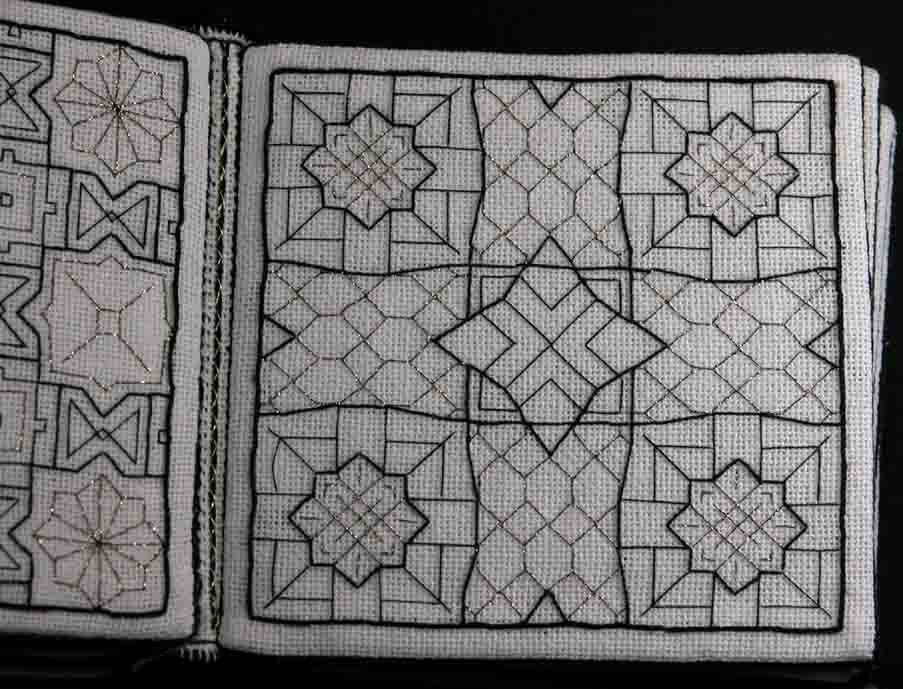 Le point holbein, point de base de tout le blackwork, possède la particularité qu'il peut être réversible. Cela signifie que l'ouvrage présente le même aspect, aussi bien au devant qu'à l'envers de la toile. C'était assez important lorsqu'on se servait du blackwork pour décorer les larges manches, manchettes et cols, dont les deux côtés étaient visibles.
Le point holbein, point de base de tout le blackwork, possède la particularité qu'il peut être réversible. Cela signifie que l'ouvrage présente le même aspect, aussi bien au devant qu'à l'envers de la toile. C'était assez important lorsqu'on se servait du blackwork pour décorer les larges manches, manchettes et cols, dont les deux côtés étaient visibles.Cependant, dans le blackwork contemporain on cherchera souvent en vain cette réversibilité. En effet, les sujets et les motifs des patrons modernes, par leur complexité, ne permettent plus cette réversibilité dans tous les cas. Que les débutantes dans le blackwork ne se culpabilisent donc pas si cet effet manque à leur ouvrage.
Een woordje vooraf over reversibel blackwork.
 De holbeinsteek, de basissteek in alle blackwork, heeft als kenmerk dat ze reversibel (omkeerbaar) kan zijn. Dit betekent dat het borduurwerk hetzelfde uitzicht biedt, zowel aan de voor- als aan de achterzijde van de stof. Dit had zijn belang toen blackwork werd gebruikt om wijde mouwen, manchetten en kragen te versieren, waarvan beide zijden zichtbaar waren.
De holbeinsteek, de basissteek in alle blackwork, heeft als kenmerk dat ze reversibel (omkeerbaar) kan zijn. Dit betekent dat het borduurwerk hetzelfde uitzicht biedt, zowel aan de voor- als aan de achterzijde van de stof. Dit had zijn belang toen blackwork werd gebruikt om wijde mouwen, manchetten en kragen te versieren, waarvan beide zijden zichtbaar waren.Bij het hedendaagse blackwork echter zal men deze reversibiliteit vaak tevergeefs zoeken. De onderwerpen en motieven van de moderne blackworkpatronen laten door hun complexiteit dit effect immers niet altijd meer toe. Beginnende blackworkborduursters hoeven zich dus niet schuldig te voelen indien beide kanten niet identiek zijn.
First of all a few words about reversible blackwork.

The peculiarity of the holbein stitch, the basic stitch of all blackwork, is its reversibility. This means that the embroidery presents the same aspect on both sides of the fabric. This was important when blackwork was used to decorate the wide sleeves, cuffs and collars, of which both sides were often visible.
However, in comtemporary blackwork one will often search this reversibility in vain. The themes and motives of the modern patterns, by their complexity, don't always allow this effect anymore. Therefore, starting blackwork embroiderers shoud not feel guilty when reversibility is lacking.
Quant à l'échiquier de Leon Conrad, nous sommes arrivés à la cinquième rangée : les champs b4, d4, f4 et h4. Voir mes photos ci-dessous.
In het schaakbordpatroon van Leon Conrad zijn we inmiddels toe aan de vijfde rij : de velden b4, d4, f4 en h4. Zie mijn foto's hieronder.
On the chessboard pattern of Leon Conrad we arrived at the fifth row : the fields b4, d4, f4 and h4. Have a look at my pictures below.
 |
| Columbus' Square |
 |
| Columbus' Square |
 |
| Drake's Square |
 |
| Drake's Square |
 |
| Caxton's Square |
 |
| Caxton's Square |
 |
| The Knot Garden |
 |
| The Knot Garden |
BLACKWORK : L'HISTOIRE | DE GESCHIEDENIS | THE HISTORY
 |
| Portrait de Henri VIII par Hans Holbein |
 |
| Detail du portrait de Henri VIII |
Textiel en zijde zijn erg vergankelijk en kleuren vervagen. Weinig oud borduurwerk heeft dan ook de tand des tijds doorstaan. De beste illustraties van het 16de eeuwse Engelse blackwork zijn ons trouwens overgeleverd via de portretten van Hans Holbein, de Duitse hofschilder van Hendrik VIII. De precisie waarmee deze kunstenaar de blackworkmotieven op hemden, mouwen en kragen heeft weergegeven is zo realistisch dat op basis van zijn schilderijen de patronen ervan konden worden gereconstrueerd. Om die reden staat de dubbele rijgsteek, de belangrijkste in alle blackworkborduurwerk, dan ook als de holbeinsteek bekend.
Textiles and silk are fragile and perishable and colours fade. So, few embroideries have stood the test of time. However, the best illustrations of the 16th century English blackwork have been transmitted to us by the portraits of Hans Holbein, the German court painter of Henry VIII. The precision with which this artist has reproduced the blackwork models on shirts, sleeves and collars is so realistic that the patterns could be reconstructed based on these portraits only. For this reason the double running stitch, which is the most important stitch in all blackwork embroidery, is better known as the holbein stitch.
A suivre... | Wordt vervolgd... | To be continued...

Aucun commentaire:
Enregistrer un commentaire
Pour vous aider à publier votre commentaire, voici les démarches à suivre :
1) Ecrivez votre texte dans le formulaire de saisie ci-dessus.
2) Saisissez votre nom, initales ou pseudonyme en bas de votre texte.
3) Puis choisissez un profil en cliquant sur "Anonyme" ou sur votre compte dans la liste déroulante "Commentaire".
4) Cliquez sur "Aperçu" pour vérifier votre message
5) Enfin, si cela vous convient, cliquez sur "Publier".
Voilà : c'est fait.
Et un gros MERCI !
Yolande